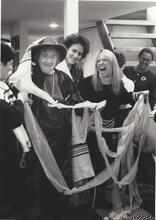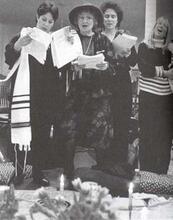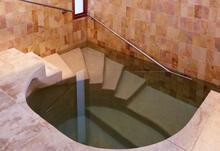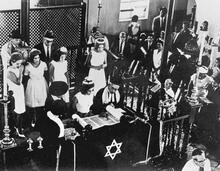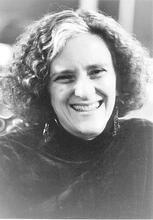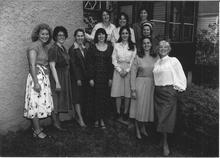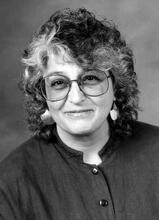Feminist Jewish Ritual: An International Perspective
Pictured here is a page from The Journey Continues: The MA'YAN Passover Haggadah. (New York: MA'YAN, the Jewish Women's Project, 2000), a manual for the seder which gives voice both to the women who experienced the Passover events of the past and those celebrating the holiday in the present.
Institution: MA'YAN, Library of Congress
Beginning with the first bat mitzvah in 1922, Jewish women began adapting traditional ceremonies and customs, such as seders and Rosh Hodesh ceremonies, to focus on women. Other rituals have been created for parts of the female life cycle such as menstruation or childbirth. Wedding and divorce rituals have been rewritten to be more egalitarian by removing language that implies a husband’s ownership over his wife. Ceremonies surrounding the birth of a child have been adjusted to give the same attention and respect to the birth of a female child as is traditionally given to the birth of a male. However, there continues to be a lack of recognition of women in recently created holidays that are based on nationalist and Zionist beliefs.
Introduction
Because religious praxis involving material objects plays so major a role in Jewish religion, one of the most significant expressions of the creation of feminist Judaism and its influence on the Jewish people is women’s wide-ranging involvement in the full range of ceremonies that exist both within and beyond The legal corpus of Jewish laws and observances as prescribed in the Torah and interpreted by rabbinic authorities, beginning with those of the Mishnah and Talmud.halakhah. This revolution has four main modes of expression. The most prominent and widely accepted of them are egalitarian ceremonies, which create and express the desire for equality between women and men in religious ritual, from which women were either actively excluded or in which they were in the past permitted only minimal participation.
The pioneers of Jewish feminism in the nineteenth century may be seen as also being those who paved the way for the inclusion of women in Jewish prayer and ritual, which until that time had been defined as exclusively the domain of men. Among their revolutionary ritual acts, we can number the donning of phylacteries and the wearing of a prayer shawl by Hannah Rachel Werbermacher, the Maid of Ludomir, who was also the first and only woman to conduct a hasidic court; the insistence of Henrietta Szold (1860–1945, the founder of the Hadassah organization, Hadassah Hospital, schools for nursing and social work and the director of Youth Aliya) on reciting the Lit. (Aramaic) "holy." Doxology, mostly in Aramaic, recited at the close of sections of the prayer service. The mourner's Kaddish is recited at prescribed times by one who has lost an immediate family member. The prayer traditionally requires the presence of ten adult males.Kaddish for her deceased parents; and the activity of prayer leader Ray Frank, the first woman to preach in liberal synagogues, who served as an itinerant rabbi in various communities in the western United States at the end of the nineteenth century.
Yet beyond these historical anecdotes, it was the Lit. "daughter of the commandment." A girl who has reached legal-religious maturity and is now obligated to fulfill the commandmentsbat mitzvah ceremony, which began to develop in the early twentieth century, that blazed the trail to equality. In the wake of the first bat mitzvah ceremony, there followed egalitarian weddings and naming ceremonies for daughters (together with the addition of spiritual components to the circumcision ceremony for male infants). This egalitarian consciousness paved the way for the creation of hundreds of new ceremonies that express the feminist desire for cultural equality, reflect the female life cycle, and have no precedent in normative halakhah.
These ceremonies deal mostly with various aspects of women’s lives and bodies. They may involve purification after rape, sexual exploitation, or sexual harassment, or celebrate menarche, conception, birth, and menopause. Most of the new ceremonies are based in one way or another upon female traditions, such as preparation ceremonies for a wedding, fertility rituals, or ceremonies that marked old age and the anticipation of death, which existed on the fringes of masculine culture. The renewal of these feminine folk traditions finally led to feminist interpretations of those ceremonies in halakhah that are intended for women, particularly the monthly immersion in the Ritual bathmikveh. Finally, other ceremonies reflect the empowerment of women via creative-feminist development of the The legal corpus of Jewish laws and observances as prescribed in the Torah and interpreted by rabbinic authorities, beginning with those of the Mishnah and Talmud.halakhic and folk traditions connected with the Jewish calendar. The best-known examples of this are women’s seders and The new moon; the first day of the month; considered a minor holiday, especially for women.Rosh Hodesh ceremonies. Despite the schematic division into these four categories, nearly every Jewish feminist ceremony contains each of the following four elements: liturgical expression of equality; feminist religious language; renewal of folk traditions that were marginalized over time; and innovative, empowering interpretation of normative halakhic customs.
Bat Mitzvah
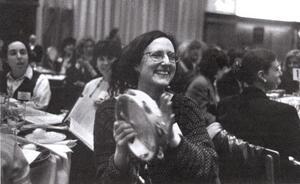
One aspect of feminist ritual development is the modification of existing rituals to enable women's full participation and recognition. A primary example is the participation in seders which highlight women's contribution to the Passover story. This photograph was taken at MA'YAN's first Community Feminist Seder, which was held in 1994. More than two hundred women attended.
Photographer: Joan Roth
Although there are undocumented reports of bat mitzvah ceremonies in Germany at the end of the nineteenth century and the beginning of the twentieth, the best-known such ceremony was the bat mitzvah of Judith Kaplan Eisenstein, daughter of the Jewish-American philosopher Rabbi Dr. Mordechai Kaplan, who himself wrote on women’s rights in Judaism and did a great deal to advance them. The ceremony took place on 18 Adar 5682 (March 18, 1922) at the Society for the Advancement of Judaism (SAJ) on New York City’s Upper West Side. Judith Kaplan was called to the Torah she-bi-khetav: Lit. "the written Torah." The Bible; the Pentateuch; Tanakh (the Pentateuch, Prophets and Hagiographia)Torah during the Sabbath morning service, chanted the blessings before and after the Torah reading, and read a small section of the weekly Torah portion from the scroll. Her father chanted the haftarah and the blessings before and after it. This ceremony shows the great ambivalence toward women’s equal participation in synagogue ritual that prevailed even among the more liberal factions of Judaism. Judith Kaplan’s role in the prayer service was less than that of Lit. "son of the commandment." A boy who has reached legal-religious maturity and is now obligated to fulfill the commandmentsbar mitzvah boys, and adult women in the same congregation began to be called to the Torah only twenty years later. Yet the ripples of this revolutionary event, which spread throughout the Jewish world, marked the beginning of a revolution. Gradually, non-Orthodox congregations began to call girls and women to the Torah, accompanying the innovation with halakhic rulings by the liberal streams (Reform, Conservative, and Reconstructionist).
The reservations regarding women’s Lit. "ascent." A "calling up" to the Torah during its reading in the synagogue.aliyot to the Torah stemmed from a Talmudic dictum, “Women should not read from the Torah because of kevod zibbur” (the honor of the congregation) (BT Lit. "scroll." Designation of the five scrolls of the Bible (Ruth, Song of Songs, Lamentations, Ecclesiastes, Esther). The Scroll of Esther is read on Purim from a parchment scroll.Megillah 23a). Yet the same section in the Lit. "teaching," "study," or "learning." A compilation of the commentary and discussions of the amora'im on the Mishnah. When not specified, "Talmud" refers to the Babylonian Talmud.Talmud reads: “All are qualified to be among the seven [who read], even a minor and a woman.” The halakhic thinking permitting this change, which became more popular from the 1950s on in the Conservative movement, was based mainly on the assertion that a woman reading from the Torah does not compromise the honor of a modern congregation, where women and men study Hebrew literacy and Torah together (which was not customary in Jewish society during Talmudic times, when the spiritual world of men was completely separate from that of women, and very few women were literate). On the strength of this liberal-halakhic ruling, adult women began to receive aliyot and to read from the Torah in the Conservative movement. In the Reform movement halakhic constraints did not apply. Bat mitzvah ceremonies were held in the two movements in the last decades of the twentieth century for groups of adult women or individual women who had not received an Lit. "ascent." A "calling up" to the Torah during its reading in the synagogue.aliyah to the Torah as girls.
The widespread popularity of the bat mitzvah ceremony gave rise to a great variety of customs in liberal communities that stop short of full equality between the sexes. Thus, in several liberal congregations in South America it was customary to call all the bat mitzvah girls to the Lit. "elevated place." Platform in the synagogue on which the Torah reading takes place.bimah on Friday night for a blessing from the rabbi. In some Conservative congregations throughout the world, the bat mitzvah girl would read only from the Prophets, not from the Torah. Toward the end of the twentieth century, the bat mitzvah ceremony in most liberal congregations in North America became completely identical to the Lit. "daughter of the commandment." A girl who has reached legal-religious maturity and is now obligated to fulfill the commandmentsbar mitzvah ceremony in every way, including the wearing of a Four-cornered prayer shawl with fringes (zizit) at each corner.tallit and the laying of Phylacteriestefillin for those who wished to do so (relying on rulings that permitted this, especially that of Rabbenu Tam of Ashkenaz, one of the greatest Tosafists [1100–1171]; see Lit. "additions." Collections of comments made by Rashi's students and descendants who undertook to expand, elaborate and develop Rashi's commentary on the Talmud.Tosafot to The Jewish New Year, held on the first and second days of the Hebrew month of Tishrei. Referred to alternatively as the "Day of Judgement" and the "Day of Blowing" (of the shofar).Rosh Ha-Shanah 33a. Beginning with the last decades of the twentieth century, bat mitzvah ceremonies also began to develop in Orthodox congregations. The options for Orthodox bat mitzvah girls include giving a devar Torah or leading a women’s or mixed public Torah study (the more popular option) during the bat mitzvah’s festive meal; reading from the Torah in a women’s congregation (where sometimes the bat mitzvah’s close male relatives watch from behind a partition); and reading from the Torah for a mixed congregation in a synagogue which uses a Synagogue partition between men and womenmehizah, as is done in a few Orthodox congregations in the world. Bat mitzvah ceremonies also paved the way for women to wear a tallit and lay tefillin for daily prayer in those congregations.
Marriage and Divorce
Bat mitzvah ceremonies and weddings with egalitarian elements began to evolve with the German Reform movement in the nineteenth century. However, to the best of our knowledge, the bat mitzvah ceremonies were done for groups of girls and they did not participate in the Torah service. The challenge for the couples who developed these egalitarian elements lay in the fact that the existing halakhic wedding ceremony marks the “purchase” of the woman by the man who is marrying her. This act of acquisition, or The act whereby a person voluntarily obtains legal rights over an object.kinyan, is legally similar to the act of acquiring slaves or property and has harsh implications for the woman, rendering her unequal to the man in the entire halakhic system of marriage and divorce (Codification of basic Jewish Oral Law; edited and arranged by R. Judah ha-Nasi c. 200 C.E.Mishnah Lit. "sanctification." Prayer recited over a cup of wine at the onset of the Sabbath or Festival.Kiddushin 1:1). The bride indicates her agreement to the marriage by accepting the kiddushin money, which is today represented by the wedding ring. Yet, unlike the groom, who promises before witnesses to honor his commitments to the bride when the Marriage document (in Aramaic) dictating husband's personal and financial obligations to his wife.ketubbah is signed, consecrates the bride with a ring, and finally breaks the glass, the bride stands mute and passive beneath the wedding canopy. Early attempts among liberal religious groups to change this imbalance did not address the question of the halakhic inequality of groom and bride but offered only a variety of aesthetic solutions. For example, the bride gave her husband a ring and recited various Biblical verses, usually from the Song of Songs, about a woman’s love for a man: “My beloved is mine, and I am his” (Song of Songs 2:16), “Set me as a seal upon your heart” (8:6), or “I shall call you husband, no longer master” (adapted from Hosea 2:18). In accord with the woman’s new speaking role at the ceremony, the wording of the ketubbah was also broadened and changed to include the bride’s commitments to her groom (which were not always identical with the groom’s commitments to his bride).
Later, couples and rabbis who were more aware of the inequality of bride and groom began to create completely egalitarian ceremonies in which the bride also said to the groom, “Behold, you are consecrated to me according to the law of Moses and Israel.” Alternatively, they might use other halakhic declarations, the most popular of which was “Be my wife” or “Be my husband according to the laws of Moses and Israel.” Advocates of this approach opine that the very equality in the language of consecration removes the legal significance of the kinyan.
Yet neither Orthodox nor radical feminists are completely satisfied with this solution since, according to some halakhic opinions, egalitarian marriage still constitutes legal acquisition of the bride. As a result, even after an egalitarian Jewish wedding ceremony, the process of divorce can render a Jewish woman an Woman who cannot remarry, either because her husband cannot or will not give her a divorce (get) or because, in his absence, it is unknown whether he is still alive.agunah or the victim of a recalcitrant husband who refuses to grant her a Writ of (religious) divorceget. Those who advocate a Jewish wedding ceremony that contains no trace of kinyan of the bride believe that the language in which the bride and groom enter the covenant of marriage with each other needs to find inspiration in other halakhic contractual formulas.
From an Orthodox standpoint, Meir Simhah ha-Cohen Feldblum proposed that the groom consecrate the bride with the sentence “Harei at meyuhedet li” (Behold, you are unique to me), which halakhah does not consider an act of kiddushin according to the law of Moses and Israel but only as a “mode of marriage,” and therefore does not constitute legal acquisition of the bride even after the fact. Rachel Adler, a Reform feminist theologian, bases the process of establishing a family on the halakhic structure of a business partnership in which each partner contributes according to his or her means and in which their assets are divided equally should the partnership be dissolved (BT Ketubbot 93a; Moses ben Maimon (Rambam), b. Spain, 1138Rambam, Laws of Emissaries and Partnership 4:1–3, 10:5). Both partners place an object dear to them in a joint purse instead of giving the ring, which symbolizes the acquisition of the woman with kiddushin money. Adler also regards this marriage ceremony, called brit ha-ahuvim (covenant of the loved ones), as appropriate for both heterosexual and same-sex couples.
Jewish feminist divorce ceremonies have evolved in an attempt to balance the inequity of a traditional divorce ceremony, in which the husband divorces his wife by giving the get and the woman is divorced upon receiving it. The issue of get has ramifications for illegitimacy in Judaism, since any woman who has not received a religious divorce is considered still legally married to the man from whom she has separated, and her children by any other Jewish man will therefore be considered mamzerim (bastards), permitted to marry only other mamzerim or converts.
Feminist efforts are therefore directed primarily to ensuring that Jewish women receive divorces without extortion or harm to their self-respect or freedom of choice. A majority of Jewish feminists prefer not to become involved with the process of granting a halakhic divorce but rather seek to balance it with an additional ceremony in which the woman writes a get to her former husband. While this ceremony has no halakhic status, it does have spiritual significance. In it, the woman frequently adopts some customs of mourning to mark the end of her marriage, such as walking around her home accompanied by close friends, or else she in some way marks the beginning of new life and new hope.
Birth of a Child
The ceremonies marking the birth of a child, especially the birth of a daughter and her entry into the covenant of the Jewish people, reflect the encounter between ideological interpretation and liberal cultural and radical feminism. The classic sources of Jewish tradition viewed the birth of a daughter with at best limited joy, according to the dictum, “Happy is he whose children are males; alas for him whose children are females” (BT Bava Batra 16b). Therefore, the blessing which according to halakhah is recited by the father upon learning of the birth of a son— “Blessed be You, our Lord and God, Ruler of the Universe, who is good and who does good”—is not recited upon the birth of a daughter, though the blessing of She-Heheyanu is recited. Neither is there any ceremony mandated by halakhah that expresses the community’s joy upon the birth of a daughter. The only congregational expression for the birth of a girl in the pre-modern period was the honoring of her father with an aliyah to the Torah, which took place in only some congregations. In Descendants of the Jews who lived in Spain and Portugal before the explusion of 1492; primarily Jews of N. Africa, Italy, the Middle East and the Balkans.Sephardic synagogues, the cantor also sings verses from the Song of Songs in honor of the birth. In various ethnic groups the baby is welcomed with local folk ceremonies such as the hollekreisch, a ceremony customary in medieval Ashkenaz in which baby boys and girls were given their non-Hebrew names. Children would surround the baby’s cradle, raising and waving it from side to side while shouting “Holle! Holle!”
Simhat bat ceremonies that were feminist-inspired revived some of these folk traditions and added parts of various Jewish ceremonies (Lit. "distinction, division." The blessing recited at the close of the Sabbath and Festivals to indicate the distinction between holy and ordinary days.havdalah, immersion in the mikveh, ritual hand-washing, circumcision), as well as of Biblical, midrashic, and halakhic ceremonies. All these created a “weave of ceremony” of which no specific ceremony has so far emerged as definitive. On the contrary: most ceremonies include elements from various others.

Over the past quarter of a century, feminists have developed a variety of new rituals to highlight women's life cycle events, in some cases building on traditional forms of female-oriented ritual. One example is the Simhat Bat ceremony to welcome baby girls, which finds precedent in the Zeved ha-Bat birth ceremonies held in past and present Sephardi, North African, and Syrian communities. Pictured here is a guide to the Simhat Bat ceremony published by the Jewish Women's Resource Center of the National Council of Jewish Women.
Institution: Eleanor Leff Jewish Women’s Resource Center (JWRC) of the National Council of Jewish Women, New York Section
Some seven models of brit banot, or simhat bat, currently exist in liberal religious congregations, with each model employing an element from another ceremony in halakhic literature. Those that center around candle-lighting emphasize women’s kindling of the Sabbath lights on Friday evenings, together with the candle’s role in Jewish tradition as a symbol of the soul and Divine light. Some people light seven candles to symbolize the six days of Creation and the Sabbath, while some light only six, with the baby symbolizing the light of the Sabbath’s sanctity.
The connection between femininity and water in Judaism, which finds expression inter alia in midrashic accounts of Miriam’s well (Pesika Zutarta on Parshat Hukkat; BT SabbathShabbat 35a), and the major significance of immersion in the mikveh in the life of an adult Jewish woman lead some families to immerse their daughters in an actual mikveh or in a “mikveh spring,” a bath or bowl of water (preferably rainwater), decorated with verses from the Torah or the A type of non-halakhic literary activitiy of the Rabbis for interpreting non-legal material according to special principles of interpretation (hermeneutical rules).Midrash. Those who prefer not to immerse their daughters in the mikveh because of the similarity between that and Christian baptism but still wish to emphasize the connection between femininity and water may choose to follow the suggestion of Rabbi Ruth Sohn to wash their daughter’s feet instead of immersing her entire body. This custom, which has no parallel in Christianity, is based on customs of hospitality described in the Torah, for example when the patriarch Abraham welcomed the angels (Genesis 18:4). The use of water as a ritual element in the simhat bat ceremony is based on the midrashic-halakhic tradition of Rabbi Menahem ben Solomon ha-Meiri of Provence (1249–1306), who wrote in his commentary on the Talmud (Beit ha-Behirah on Yevamot 46a) that when Abraham entered the covenant by circumcision, Sarah immersed in the mikveh (both of which acts are part of the Jewish conversion ceremony). The Meiri’s interpretation strengthens the perception of the simhat bat as a parallel to the brit milah, both historically and in terms of halakhic innovation.
Those who have reservations about washing or immersion in water wrap their daughter in a tallit symbolizing the four corners of the earth, or carry her between two lines of men and women into the community or the synagogue. Another option, proposed by Talmudic researchers Tirzah Meacham and Zevi Fuchs, combines the priestly brit milah ceremony (Numbers 18:19), the particulars of which we do not know, with the ancient custom of “salting” babies after birth in order to purify them and drive away evil spirits (Ezekiel 16:4). In this ceremony, salt is sprinkled over the baby, or she is given a tiny bit of salt to taste to symbolize the five senses and/or the fact that life is precious and rare, as was salt during ancient times.
Even though all the ceremonies may be held a month after the birth, when the mother has recovered, most writers of ceremonies recommend celebrating on the eighth day after birth. Unlike these ceremonies, the brit ha-bat ceremony held as a havdalah ceremony at the end of the first Sabbath of the Hebrew month after the baby’s birth, when Lit. "sanctification." Prayer recited over a cup of wine at the onset of the Sabbath or Festival.kiddush ha-levanah is recited, deliberately differs from the circumcision ceremony, since it is not subject to the counting of eight days after the birth and is conducted at night, while circumcision and simhat bat ceremonies are held during the day. Thus, it represents the cyclicity of time and the lunar cycle in particular, which both Jewish and other traditions identify with the female.
This detailed attention to the type of ceremony, its elements and texts and the time at which it is held indicate how carefully feminist commentators deliberate regarding how much to allow patriarchal halakhic tradition to conceptually and halakhically impinge on the format of the ceremony. These deliberations also find expression in the choice and composition of blessings that accompany the ceremony’s rituals. Orthodox families are more limited in their ability to choose ceremonies and blessings for the birth of a daughter because of the prohibition of berakhah le-vatalah, reciting a blessing in vain (using blessings written by the sages in circumstances that deviate from halakhic norms).
In naming the baby, Conservative feminist custom tends toward existing blessings from the circumcision ceremony or other blessings of enjoyment noted in the prayer book or the Talmud, together with verses from Psalms or the Song of Songs. Radical liturgical approaches find expression in new blessings with images from nature or feminine images as descriptions of the Deity, including Shekhinah, Source of Living Waters, Wellspring of Life (in prayers by Marcia Falk), or “wisdom of the world.” Proponents of this liturgical theological approach point out that when the community welcomes a girl into the world, it is appropriate to remember the female aspects of the Deity in whose image the newborn baby was created.
An interesting development that derived from the welcoming ceremony for baby girls is a fresh look at the circumcision ceremony from a feminist perspective. Radical feminism rejects this ceremony completely since it embodies all aspects of the oppression of women and anything representing femininity: the source of the covenant between the Jewish people and God is represented in the male sexual organ while women, who carry and bear children, are ignored, wiped out of the national memory because their bodies are different from those of men. The circumcision ceremony constitutes the deliberate wounding of the penis, signifying an alienation from the material, from the body, and from nature, all of which are symbolized in world cultures as female. The sealing of the covenant on male flesh is therefore the expression of a patriarchal world view that controls the individual by doing violence to his body.
Yet in spite of all reservations, only very few Jewish feminists suggest not circumcising boys. Most explain their decision to circumcise their sons in symbolic anthropological terms: the significance of circumcision lies in belonging to the tribe, to the Jewish people, placing a seal on the baby boy. In another explanation, by Reform rabbi Laura Geller, the blood of circumcision is likened to the blood of birth, creating a connection between the baby and his father just as the blood of birth embodies the first connection between a mother and her children.
Feminist ambivalence toward the circumcision ceremony has led some Jewish feminists to celebrate the circumcision of their sons on the eighth day privately while holding a different celebration for family and community called Simhat Lev (joy of the heart), which comprises prayers and blessings and sometimes a reading from the Torah. Traditional Jewish feminists try to participate in the circumcision ceremony as much as the father, wearing a tallit during the ceremony, reciting some or all of the blessing, and adding readings with feminist spiritual significance. (According to halakhah, fathers are obligated to circumcise their sons but in light of the Torah precedent of Zipporah, wife of Moses, who circumcised her son, a woman may perform the act of circumcision [Shulhan Arukh, Yoreh De’ah 264:1].)
“Life Cycle” Ceremonies
The inclusion of girls and women in life-cycle ceremonies determined by halakhah has led to expanded significance for the term “life cycle.” One groundbreaking feminist ceremony that has extended the concept of the life cycle is the Simhat Hokhmah ceremony which celebrates a woman’s transition into the “golden age.” In a certain way this ceremony is a revival of the ceremony of sewing of shrouds once customary in Sephardic communities in Europe and the Balkans, where the public sewing of shrouds was perceived as a charm guaranteeing long life. The ceremony was adopted and developed into one with a unique liturgical quality by Savina Teubal, a leading Jewish feminist in Los Angeles, California, on reaching her sixtieth birthday. In its feminist version, Teubal moved the ceremony to the morning prayers in the synagogue, including a Torah reading from the section entitled Lekh Lekha (Genesis 12–17). This section of the Torah, which was not necessarily read at its correct time in the annual reading cycle, describes the journey of Abraham and Sarah to the land of Canaan and thus, metaphorically, the journey of the woman celebrating her Simhat Hokhmah through life into old age. At the height of the ceremony, Teubal appeared in the white robe that will eventually enwrap her body in death, when she returns her soul to her Creator. At the close of the ceremony, she planted a tree in the synagogue courtyard to mark the connection between the conceiving of life, symbolized by the roots in the belly of the earth, and its peak, symbolized by the tree branches. The ceremony combined musical-liturgical elements composed by two leading women in the field: Marcia Falk, poet and writer of prayers, and liturgical composer Debbie Friedman.
Another ceremony, like the Simhat Hokhmah ceremony relevant to women and men alike, is the ceremony of “coming out of the closet,” developed by lesbian feminist theologian Rebecca Alpert. She suggests that the ceremony should take place in the synagogue on Shabbat Shirah, which falls near Tu bi-Shevat and on which one reads Parshat Be-Shalah, which contains the Song at the Sea describing the Exodus from Egypt and the crossing of the Sea of Reeds. On this Sabbath, the gay or lesbian Jew is called to the Torah for a special aliyah marking the public revelation of his or her sexual orientation. The ceremony marks their coming out of “Mizrayyim,” from the mezarim or narrow straits where they concealed their sexual identity and inner truth. As of the early twenty-first century, this ceremony could take place in Orthodox communities or even in most Conservative ones, since they consider public and ritualistic expressions of homosexuality unacceptable within the parameters of their halakhic interpretations.
The expansion of the human life cycle in Judaism by Jewish feminists arose from an increasing awareness of woman’s body and the biological processes that occur within it. The moment religious awareness takes the body into account, especially the female body with its typical life cycles, the need arises to give religious expression to these additional phenomena, which were not related to by the formulators of halakhah. As a result of this increased awareness, some Jewish feminists adopted the custom that once existed in some Jewish communities in Muslim countries of celebrating the onset of menarche in a private ceremony held by the women of the family with the adolescent girl. But while menarche ceremonies in pre-modern Jewish communities were held without any liturgical framework or defined ritual, many of the different religious streams have created ceremonies for this event.
Similarly, ceremonies have been written in which women celebrate a birth with the new mother, ceremonies for “welcoming the mother” that have become popular in Orthodox feminist circles, and ceremonies connected with infertility, fertility treatments, conception, announcing the pregnancy to friends and family, preparing for the birth, weaning, miscarriage and abortion, preparation for a hysterectomy or mastectomy, purification after these operations, and menopause. The common factor in these ceremonies is the woman’s desire to mark an intimate physical transition stage that arouses apprehension and anxiety, within a supportive community, such as a group of friends or close family members. Like the Brit ha-Bat ceremony, all these ceremonies contain familiar ritual components from the halakhic liturgy, including the lighting of candles, a havdalah or memorial candle, the reading of verses from Psalms or from the Pentateuch, blessings over various forms of enjoyment or from the Eighteen Benedictions, or the inclusion of new, feminist blessings.
Mikveh
Also noteworthy is the non-traditional use of immersion in a mikveh as part of these ceremonies, especially those that mark purification and recovery from physical injury: surgery, disease, rape, or other sexual abuse. Non-Orthodox feminist groups and communities began to relate to this controversial ritual in a new way that emphasizes purification not from the impurity of monthly bleeding or from bleeding resulting from a medical condition in a woman’s reproductive organs.
While the Torah views these types of bleeding as ritually impure, transmitting impurity, and requiring abstinence from sexual contact during their occurrence and sometimes even afterwards, as well as immersion at the end of the period of abstinence (Leviticus 15:19–30), most non-Orthodox Jewish feminists view menstruation as a natural physical process that requires no purification. Nevertheless, those feminists who do not approve of traditional immersion in a mikveh suggest it as a form of purification from patriarchal forms of ethically impure behavior towards women, especially such sexual impurities as sexual exploitation, sexual harassment, rape, or any other form of sexual abuse.
These modern uses of the mikveh once again raised the question of the traditional significance of the monthly immersion among modern Orthodox women, as well as among some Conservative, Reform, and Reconstructionist feminists. On the one hand, like circumcision, ritual immersion, with its insistence on conforming to the halakhic minutiae involved, especially the requirement to “show blood to the sages”—meaning to consult with male rabbis on every question pertaining to the end of the menstrual period and preparation for immersion—constitutes a clear expression of unbridled control by Jewish men and the Jewish male institution over women’s bodies. On the other hand, the ceremony has for generations been one specifically for Jewish women. Female customs and traditions were created around it, especially those relating to the preparation of the bride for the wedding ceremony and for the wedding night.
There is therefore considerable irony in the fact that the mikveh was abandoned precisely in a generation that stresses the importance of “listening” to the female voice throughout history. This consideration gave rise to feminist interpretations of the act, the authors of which ascribe a variety of meanings to the monthly immersion, such as a woman’s monthly encounter with her body, which includes examination not only for evidence of bleeding by inserting a white cloth into the vagina before immersing, but also breast self-examination as performed by many Jewish women who are aware of their bodies (suggested by Orthodox feminist Blu Greenberg).
An existential-feminist interpretation stresses the processes of life and death, of which woman’s monthly visits to the mikveh make her more aware. Menstrual blood symbolizes the death of potential life within her, which did not bear fruit that month, while immersion in the mikveh prior to ovulation indicates both renewal (as in Ezekiel 36:25 “And I will sprinkle clean water upon you”) and our awareness of the potential of new life that can grow inside the body of a young woman every month. Theologian Rachel Adler, who expressed this idea for the first time at the beginning of the 1970s but distanced herself from it publicly twenty years later, saw it as apologetic and called upon women to immerse in the mikveh only for purification after experiencing sexual abuse. However, the assertion itself continues to exist among Jewish feminists who view the mikveh as a way of preserving their grandmothers’ traditions and empowering themselves as Jewish women in our day.
Midrashic Interpretations
As with immersion, Jewish feminism has also given significance to several dates on the Hebrew calendar that have a midrashic connection with feminine motifs. These dates have become opportunities for ceremonial gatherings, the empowerment of Jewish feminists, and the creation of commentary and liturgy. First among them is Rosh Hodesh. According to the midrash (Pirke de-Rabbi Eliezer 45), the first day of the month was given to women as a reward for their refusal to surrender their jewelry to create the Golden Calf. The midrash maintains that because of this tradition women were more meticulous in celebrating Rosh Hodesh and even abstained from work on that day. Rabbi Solomon ben Isaac; b. Troyes, France, 1040Rashi (Rabbi Solomon ben Isaac, 1040–1105) quotes this midrash in his commentary on the Talmud (Megillah 22b). With time, the custom fell into desuetude, though in some communities women customarily lit candles without a blessing on the eve of Rosh Hodesh. The original custom inspired groups of contemporary feminist women to meet at the beginning of every Hebrew month. As with simhat bat ceremonies, Rosh Hodesh has no fixed liturgical format. Orthodox feminists meet to study Torah and read from the Torah scroll on Rosh Hodesh morning, while others meet for study and discussion of a subject pertaining to the month that begins that evening. Still other groups emphasize ritual, including drama, artistic and creative activity and singing.
A similar interpretive process led to the creation of feminist A seven-day festival to commemorate the Exodus from Egypt (eight days outside Israel) beginning on the 15th day of the Hebrew month of Nissan. Also called the "Festival of Mazzot"; the "Festival of Spring"; Pesah.Passover The "guide" to the Passover seder containing the Biblical and Talmudic texts read at the seder, as well as its traditional regimen of ritual performances.Haggadot and the holding of feminist seders for women, mostly during the intermediate days of the festival rather than instead of the family Lit. "order." The regimen of rituals, songs and textual readings performed in a specific order on the first two nights (in Israel, on the first night) of Passover.seder. Here, too, a traditional foundation inspired the feminist ceremony, in this case the midrash that “the Israelites were redeemed from Egypt thanks to righteous women” (BT Suspected adulteressSotah 11b). These midrashim stand in jarring contrast with the total absence of women from the traditional The "guide" to the Passover seder containing the Biblical and Talmudic texts read at the seder, as well as its traditional regimen of ritual performances.Haggadah and the patriarchal construction of the Passover seder. Despite the fact that the entire nation was redeemed from Egypt, the men, led by the male head of the family, recite the story of the Exodus while the women—who have cleaned and prepared the house for Passover for weeks before—serve the food they cooked during the previous days and wash the dishes.
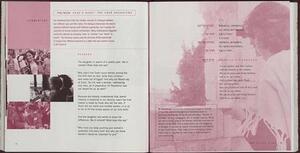
Pictured here is a page from The Journey Continues: The MA'YAN Passover Haggadah. (New York: MA'YAN, the Jewish Women's Project, 2000), a manual for the seder which gives voice both to the women who experienced the Passover events of the past and those celebrating the holiday in the present.
Institution: MA'YAN, Library of Congress
The Haggadot recited by the women at the communal feminist seders stress both women’s contribution to Israel’s redemption from slavery and their own continued enslavement. Unlike the Passover Haggadah’s ideological intent, which emphasizes the freedom of the children of Israel even during times of subjugation and persecution, the object of feminist seders is to raise awareness of the hidden oppression of women, which they themselves tend to repress and internalize in various ways. Thus, some feminist Haggadot depict the Ten Plagues as ten kinds of subjugation of women, the Four Daughters as four types of women who respond to subjugation in four different ways, and so on. Such seders take place all over the world, attracting a growing number of women who see these events as an expression of women’s empowerment.
All the aforementioned ceremonies bestow feminist significance on events and dates in the Hebrew calendar and the human life cycle, as well as Jewish significance on events in a woman’s life. However, unlike these ceremonies, the “Mishkan Ceremony” developed by Rabbi Lynn Gottlieb of the Jewish Renewal Movement is based on a Native American tradition with which she became acquainted while serving as a rabbi in New Mexico. In this ceremony, a kind of “mishkan” is built for prayer that includes drumming, singing, dance, and immersion in a spring of living water, a mikveh. Its object is to strengthen those who participate in it, sometimes a single participant, via the group of women celebrating the ceremony. Like other women’s ceremonies in pre-modern Jewish communities (such as the North African shehur) that closely resembled ceremonies held by women in the surrounding community, here too the liturgy includes Biblical verses and passages of Hebrew poetry that emphasize the appeal to a “female Deity,” the Shekhinah.
Exclusion of Women in Ceremonies
Having surveyed the various feminist attitudes to Jewish ceremonies, it is appropriate to note the absence of a feminist tradition of revising and interpreting national secular ceremonies such as Holocaust Martyrs’ and Heroes’ Remembrance Day, Memorial Day and Independence Day. Just as religious ceremonies throughout the Jewish world underwent feminization, the secular ceremonies could have undergone the same process, for example the inclusion in the readings at public ceremonies on Holocaust Day and Memorial Day of poetry and excerpts from diaries written by women. Such passages would reveal the lives of women soldiers who fell during the Zionist struggle and emphasize the hidden, every day and non-militaristic aspects of national heroism in which women and children participated.
This process has probably not yet occurred because of the ideological hostility between nationalism and feminist thought, which is based on post-modern ideas. Since at the beginning of the twentieth century Jewish feminism in Israel and elsewhere developed side by side with nationalist consciousness and because the androcentrism in Zionism is as great as that inherent in any ideology or legal system, the process of creating a feminist interpretation for some of the secular Zionist narratives and ceremonies is necessary in light of the creation of religious ceremonies presented above.
Shulamit Magnus, one of the researchers who have sought an explanation for the abundance of feminist creativity in Jewish ritual, views the phenomenon as a complete renewal deriving from tradition. Others believe that the proliferation of ceremonies indicates a steadfast struggle for continuity and community-building through ceremonies that contain a unifying societal-feminine component (Orenstein, Levi-Elwell). Apparently, both perspectives are correct, since for the first time in Jewish history women are participating in the molding and inclusion of the female experience in the practical ceremonial expressions of Jewish communal life.
However, there is no doubt that the motivation underlying the wide-ranging creation of ceremonial is the desire to ensure Jewish continuity in an era when economic and cultural conditions undermine it. All the prayers and ceremonies referred to contain a core of liturgy deriving from the Torah, the prayer book, halakhic literature and/or Jewish thought which has undergone a feminist metamorphosis designed to free it of its patriarchal context and present it in a setting concerned with the empowerment of women and their transition into full partners in the creation of Jewish culture and faith. The creation of feminist prayers and ceremonies, women’s full participation in them and their leadership in prayer and ceremony are turning feminist theology and midrash into an integral part of Jewish everyday life in modern times.
Hebrew
Cohen-Vardi, Alma, ed. Kabbalat Panim. Tel Aviv: 2002.
Friedland ben Arza, Sarah, ed. Bat Mitzvah. Jerusalem: 2001.
Lopian, Esther. “The Thunderous Silence: The Bat Mitzvah in the Orthodox Community.” In To Be A Jewish Woman, edited by Margalit Shilo, 207–216. Jerusalem: 2003.
English
Adelman, Penina V. Miriam’s Well. Fresh Meadows, NY: 1986.
Adler, Rachel. “In Your Blood, Live”: Re-Visions of a Theology of Purity.” In Lifecycles, v. 2, edited by Rabbi Debra Orenstein and Rabbi Jane Rachel Litman, 197–206. Woodstock, Vermont: 1997.
Adler, Rachel. Engendering Judaism. Philadelphia: 1998, 190–207.
Adler, Rachel. “Tumah and Taharah: Ends and Beginnings.” In The Jewish Woman: New Perspectives, edited by Elizabeth Kulton, 63–71. New York: 1976.
Agus, Arlene “This Month Is for You: Observing Rosh Hodesh as A Woman’s Holiday.” In The Jewish Woman: New Perspectives, edited by Elizabeth Koltun, 84–93. New York: 1976.
Alpert, Rebecca T. “Coming Out in the Jewish Community.” In Lifecycles vol. 1, 144–153.
Beckerman, Cheryl. “Kiddushin and Kesharin: Toward an Egalitarian Wedding Ceremony.” In Kerem: Creative Explorations in Judaism 5 (1997): 84–100.
Cohen Anisfell, Sharon, Tara Mohr and Catherine Spector. The Women’s Seder Sourcebook. Woodstock, Vermont: 2003.
Cohen, Debra Nussbaum. Celebrating Your New Jewish Daughter. Woodstock, Vermont: 2001.
Diamant, Anita. The New Jewish Wedding New York: 1985.
Falk, Marcia. “Interpretive Amidah.” In Kol Haneshamah: Shabbat Eve. Wyncote: 1989, 150–178.
“The First Bat Mitzvah, A Bat Mitzvah in Rome.” In Communings of the Spirit: The Journals of Mordecai M. Kaplan. edited by Mel Scult, Vol. I, 159, 163–164: Detroit: 2001.
Frymer-Kensky, Tikva. Motherprayer: The Pregnant Woman’s Spiritual Companion. New York: 1995.
Geller, Laura. “Brit Milah and Brit Banot.” In Lifecycles, vol. 1, edited by Debra Orenstein, 57–67. Woodstock, Vermont: 1994.
Gottlieb, Lynn. “The Mishkan Ceremony.” In She Who Dwells Within: A Feminist Vision of a Renewed Judaism. San Francisco: 1995.
Greenberg, Blu. On Women and Judaism. Philadelphia: 1981.
Hollander, Vicki. “Weathering the Passage: Jewish Divorce.” In Lifecycles, vol. 1, edited by Debra Orenstein, 201–210. Woodstock, Vermont: 1994.
Levi Elwell, Sue. Women at Worship: Interpretations of North American Diversity, edited by Marjorie Procter-Smith and Janet R. Walton, 111–126. Westminster: 1993.
Levitt, Laura, and Sue Ann Wasserman. “Mikvah Ceremony for Laura.” In Four Centuries of Jewish Women’s Spirituality, 321–326.
Magnus, Shulamit. “Re-Interpreting Miriam’s Well: Feminist Jewish Ceremonials.” In The Uses of Tradition: Jewish Continuity in the Modern Era. New York: 1992, 331–347.
Magnus, Shulamit. “Simhat Lev: Celebrating a Birth.” In Lifecycles, Vol. 1, 68–75.
Orenstein, Debra. “Introduction.” “Afterword: How to Make a Ritual.” Lifecycles vol. 1, xvii–xxix; 359–373.
Plumb, Marcia. “Simhat Brit Me’ugelet.” In Taking Up the Timbrel, edited by Sylvia Rothchild and Sybil Sheridan, 66–72. London: 2000 (hereafter cited as Taking Up the Timbrel).
Ramon, Einat. “Tradition and Innovation in the Marriage Ceremony.” In The Life of Judaism, edited by Harvey Goldberg, 105–119. Berkeley, California: 2001.
Rothchild, Sylvia. “A Ritual for the Termination of a Pregnancy.” In Taking Up the Timbrel, 92–98.
Scult, Mel. Judaism Faces the Twentieth Century: A Biography of Mordecai Kaplan. Detroit: 1993, 301–303.
Sohn, Ruth, et al. “The Covenant of Washing: A Ceremony To Welcome Baby Girls into the Covenant of Israel.” Menorah 4 (May 1983): 3–4.
Teubal, Savina. “Simchat Hochmah.” In Four Centuries of Jewish Women’s Spirituality, edited by Ellen M. Umansky, 257–265. Boston: 1992.

